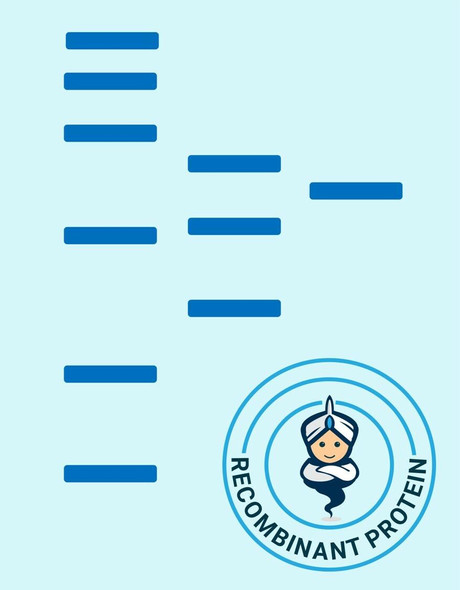Description
| Product Name: | Human HAX1 Recombinant Protein |
| Product Code: | RPPB3660 |
| Size: | 10µg |
| Species: | Human |
| Target: | HAX1 |
| Synonyms: | HCLS1-associated protein X-1, HS1-associating protein X-1, HS1-binding protein 1, HAX-1, HSP1BP-1, HAX1, HS1BP1. |
| Source: | Escherichia Coli |
| Physical Appearance: | Sterile Filtered colorless solution. |
| Formulation: | The HAX1 solution (0.5mg/ml) contains 20mM Tris-HCl buffer (pH8.0), 10% glycerol and 0.1M NaCl. |
| Stability: | Store at 4°C if entire vial will be used within 2-4 weeks. Store, frozen at -20°C for longer periods of time. For long term storage it is recommended to add a carrier protein (0.1% HSA or BSA).Avoid multiple freeze-thaw cycles. |
| Purity: | Greater than 80% as determined by SDS-PAGE. |
| Amino Acid Sequence: | MGSSHHHHHH SSGLVPRGSH MSLFDLFRGF FGFPGPRSHR DPFFGGMTRD EDDDEEEEEE GGSWGRGNPR FHSPQHPPEE FGFGFSFSPG GGIRFHDNFG FDDLVRDFNS IFSDMGAWTL PSHPPELPGP ESETPGERLR EGQTLRDSML KYPDSHQPRI FGGVLESDAR SESPQPAPDW GSQRPFHRFD DVWPMDPHPR TREDNDLDSQ VSQEGLGPVL QPQPKSYFKS ISVTKITKPD GIVEERRTVV DSEGRTETTV TRHEADSSPR GDPESPRPPA LDDAFSILDL FLGRWFRSR |
HAX1 associates with hematopoietic cell-specific Lyn substrate 1, which is a substrate of Src family tyrosine kinases. HAX1 also interacts with the product of the polycystic kidney disease 2 gene, mutations in which are associated with autosomal-dominant polycystic kidney disease, and with the F-actin-binding protein, cortactin. It was earlier thought HAX1 is mainly localized to the mitochondria, however, recent studies indicate it to be localized in the cell body. Mutations in the HAX1 gene result in autosomal recessive severe congenital neutropenia, aka Kostmann disease.
HAX1 Human Recombinant produced in E. coli is a single polypeptide chain containing 299 amino acids (1-279) and having a molecular mass of 33.7kDa. HAX1 is fused to a 20 amino acid His-tag at N-terminus & purified by proprietary chromatographic techniques.
| UniProt Protein Function: | HAX1: Promotes cell survival. Potentiates GNA13-mediated cell migration. Involved in the clathrin-mediated endocytosis pathway. May be involved in internalization of ABC transporters such as ABCB11. May inhibit CASP9 and CASP3. May regulate intracellular calcium pools. Defects in HAX1 are the cause of neutropenia severe congenital autosomal recessive type 3 (SCN3); also known as Kostmann disease. A disorder of hematopoiesis characterized by maturation arrest of granulopoiesis at the level of promyelocytes with peripheral blood absolute neutrophil counts below 0.5 x 10(9)/l and early onset of severe bacterial infections. Some patients affected by severe congenital neutropenia type 3 have neurological manifestations such as psychomotor retardation and seizures. The clinical phenotype due to HAX1 deficiency appears to depend on the localization of the mutations and their influence on the transcript variants. Mutations affecting exclusively isoform 1 are associated with isolated congenital neutropenia, whereas mutations affecting both isoform 1 and isoform 5 are associated with additional neurologic symptoms. Belongs to the HAX1 family. 6 isoforms of the human protein are produced by alternative splicing. |
| UniProt Protein Details: | Protein type:Endoplasmic reticulum; Apoptosis; Vesicle; Mitochondrial Chromosomal Location of Human Ortholog: 1q21.3 Cellular Component: transcription factor complex; nuclear membrane; mitochondrion; clathrin-coated vesicle; sarcoplasmic reticulum; lamellipodium; endoplasmic reticulum; apical plasma membrane; nuclear envelope; actin cytoskeleton Molecular Function:protein domain specific binding; protein binding; protein N-terminus binding; interleukin-1 binding Biological Process: regulation of apoptosis; positive regulation of phosphoinositide 3-kinase cascade; positive regulation of protein kinase B signaling cascade; regulation of actin filament polymerization; positive regulation of peptidyl-tyrosine phosphorylation; positive regulation of granulocyte differentiation; positive regulation of transcription from RNA polymerase II promoter; positive regulation of peptidyl-serine phosphorylation Disease: Neutropenia, Severe Congenital, 3, Autosomal Recessive |
| NCBI Summary: | The protein encoded by this gene is known to associate with hematopoietic cell-specific Lyn substrate 1, a substrate of Src family tyrosine kinases. It also interacts with the product of the polycystic kidney disease 2 gene, mutations in which are associated with autosomal-dominant polycystic kidney disease, and with the F-actin-binding protein, cortactin. It was earlier thought that this gene product is mainly localized in the mitochondria, however, recent studies indicate it to be localized in the cell body. Mutations in this gene result in autosomal recessive severe congenital neutropenia, also known as Kostmann disease. Two transcript variants encoding different isoforms have been found for this gene. [provided by RefSeq, Jul 2008] |
| UniProt Code: | O00165 |
| NCBI GenInfo Identifier: | 20141308 |
| NCBI Gene ID: | 10456 |
| NCBI Accession: | O00165.2 |
| UniProt Secondary Accession: | O00165,Q5VYD5, Q5VYD7, Q96AU4, Q9BS80, A8W4W9, A8W4X0 B4DUJ7, |
| UniProt Related Accession: | O00165 |
| Molecular Weight: | 279 |
| NCBI Full Name: | HCLS1-associated protein X-1 |
| NCBI Synonym Full Names: | HCLS1 associated protein X-1 |
| NCBI Official Symbol: | HAX1�� |
| NCBI Official Synonym Symbols: | SCN3; HS1BP1; HCLSBP1�� |
| NCBI Protein Information: | HCLS1-associated protein X-1; HAX-1; HSP1BP-1; HS1 binding protein; HS1-binding protein 1; HS1-associating protein X-1; HCLS1 (and PKD2) associated protein |
| UniProt Protein Name: | HCLS1-associated protein X-1 |
| UniProt Synonym Protein Names: | HS1-associating protein X-1; HAX-1; HS1-binding protein 1; HSP1BP-1 |
| Protein Family: | HCLS1-associated protein |
| UniProt Gene Name: | HAX1�� |
| UniProt Entry Name: | HAX1_HUMAN |










